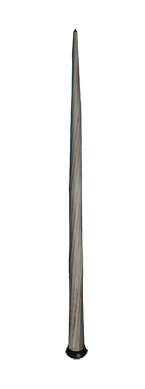Object Descriptions Ground Floor Parlor
Narwhal, i.e., “unicorn” horn
The spiral horn from the narwhal was sometimes mistaken in the Middle Ages and Renaissance for a more fantastic object, a unicorn horn.
Spenser’s New English contemporary on the Munster plantation, Sir William Herbert, lists a ’unicorn horn’ in the inventory of his household goods at Castleisland, Co. Kerry, a residence formerly owned by the earl of Desmond.
Literary Connections
Unicorns are a quintessential fantasy-animal of the middle ages, both then and now, and are often associated with virgins and/or princesses in peaceful garden settings, as in the famous tapestries now in the Cloisters museum in New York. Surprisingly, however, the beast appears in the Bible as a violent animal (Job 39.12-15), beaten only by its enemy, the lion. Spenser uses this idea in an epic simile describing the battle of Guyon, the hero of Temperance, with the wrathful villain Pyrochles, in Book II of The Faerie Queene. Guyon is compared to a treed lion, and Pyrochles to a unicorn that charges the tree and sticks its horn into it, thus trapping itself and so becoming a “feast” for the lion:
Like as a Lyon, whose imperiall powre
A prowd rebellious Vnicorne defyes,
T’auoide the rash assault and wrathfull stowre
Of his fiers foe, him [i.e., the Lion] to a tree applyes,
And when him ronning in full course he spyes,
He slips aside; the whiles that furious beast
His precious horne, sought of his enimyes
Strikes in the stocke, ne thence can be releast,
But to the mighty victor yields a bounteous feast. (FQ II.v.10)

Guyon wins the day, and the moral is that wrathful behavior will undo itself, no matter how great its powers. The passage also has a political dimension in that Guyon is associated with the “Lyon,” a symbol of both the English monarchy and (in this stanza) “imperiall power.” Against it, the unicorn becomes “prowd rebellious.” This description suits any Irish rebel —or any rebel at all— from Spenser’s point of view. Both Pyrochles and his equally angry brother Cymochles could therefore allegorize Irish rebels in particular, as they capture the essence of the “prowd” wrath of Spenser’s enemies.
Spenser mentions the narwhal in The Faerie Queene but calls it a “Monoceros.” It appears in a list of dreadful sea-monsters that were transformed from men into fish-shapes by the evil witch, Acrasia:
Most vgly shapes, and horrible aspects,…
Bright Scolopendraes, arm’d with siluer scales,
Mighty Monoceros, with immeasured tayles. (FQ II.xii.23.1, 8-9)
Bibliography:
Jonathan Bouchier, “Spenser: Description of Fishes.” Notes and Queries 93 (March 1896), 228-9.
Rev. Kieran O’Shea, “A Castleisland Inventory, 1590.” Journal of the Kerry Archaeological and Historical Society 15-16 (1982-3), 37-46.
Clarence Steinberg, “Atin, Pyrochles, and Cymochles: on Irish emblems in The Faerie Queene.” Neuphilologische Mitteilungen 72 (1971), 749-61.
John Webster and Richard Isomaki, “Pyrochles, Cymochles.” The Spenser Encyclopedia. Ed. A. C. Hamilton (Toronto: U of Toronto P, 1990), 574-5.